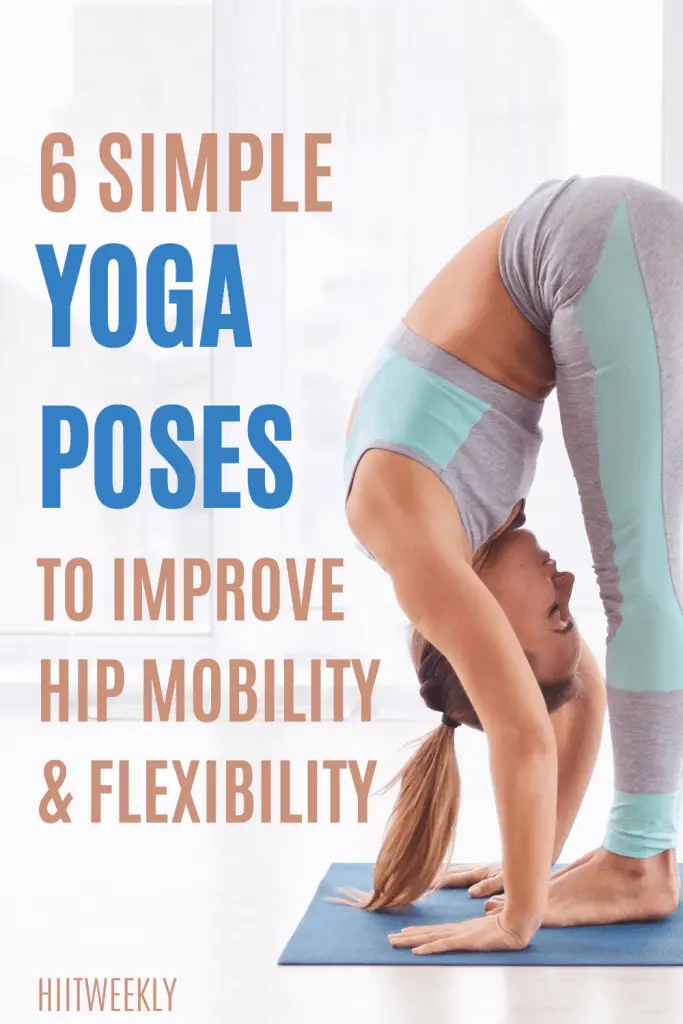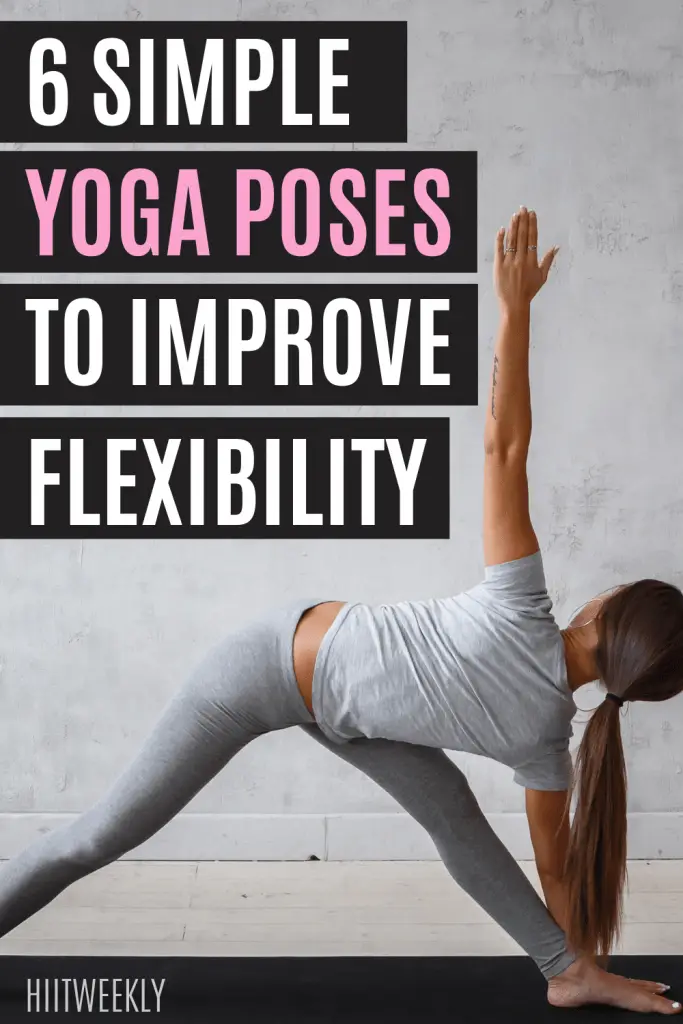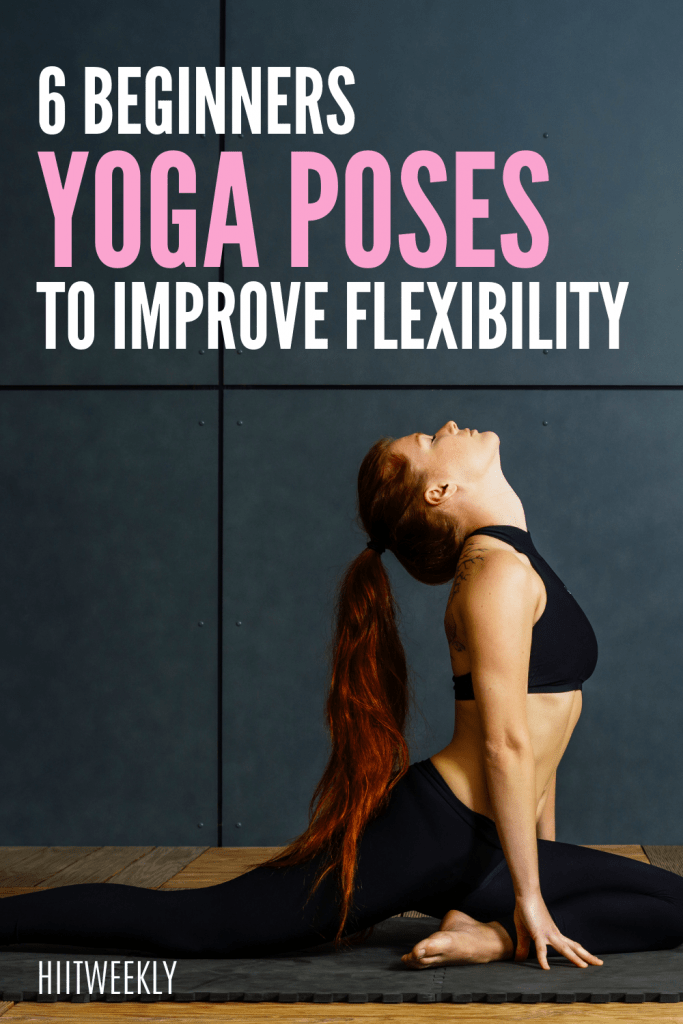
Yoga is one of the best ways that you can increase your flexibility at your own pace in a controlled environment. Our beginners yoga for flexibility routine will help open your hips and become more mobile.
It’s a common belief that you have to be flexible to do yoga. You have probably heard someone say, “I’m not flexible enough to do yoga.” Maybe you’ve even thought of it yourself. However, this is an expression that we should eliminate from our thinking. Forget about the notion that you have to have a certain degree of flexibility to enjoy this beautiful discipline.
If you are a follower of HIIT Weekly and are a fellow HIIT lover, then starting yoga will do you a whole world of good. The constant stress of daily life plus our high-intensity workouts will take its toll on your body. Performing these yoga poses will help you become more flexible.
Interestingly, to be able to perform and train properly you do need a certain degree of flexibility. These yoga poses could therefore improve your workout performance, especially if you are on the inflexible side.
Today, we will share some simple yoga poses to gain flexibility, which you can do without problems.
Unlike other activities, when practicing yoga, the actual physical objective does not lie in reaching absolute perfection in the form of each asana (pose).
Although we are acquiring more skills over time, managing to make asanas increasingly complex, the important thing is to live and enjoy the process and make the most of our particular situation. Through constant practice, flexibility will come, little by little.
So if you are one of those who can hardly lean forward (let alone touch their feet!), do not fear. Every starting point is valid.
Benefits of gaining flexibility

Children are generally extremely flexible, if you have children of your own you will appreciate what we mean. During play, they can do things with their bodies that the average adult cannot do even with the greatest effort. And it is that, over time, the lack of movement makes our muscles and joints feel stiffer and stiffer, less elastic.
We stop climbing trees; we do not crawl on the ground; We leave physical play aside and change it for sedentary activities. The good news is that you can regain lost mobility and even go further with the help of yoga.
There are many reasons to regain and maintain flexibility. Its benefits are reflected outside the mat, in daily life. Among other things, being more flexible helps you:
- Live a more active lifestyle. A body open to movement makes physical activity stop feeling like a burden and becomes much more fun.
- Prevent injury. An agile body adapts more easily to unexpected changes and movements, which can occur in sports or the gym and in everyday life.
- Improve your posture. Lack of flexibility causes a higher amount of stress in places where it shouldn’t exist. The most common bad posture pains are those of the back, neck, and shoulders, but the impact is also seen in the rest of the body. Low back and lower back pain decrease significantly by unlocking the lower body muscles.
Beginners yoga for flexibility- Yoga poses to gain flexibility
Maybe you can run a marathon without problems, but sitting with your legs stretched out, and folding forward is a titanic task. This happens because, much of the physical activities that are practiced today focus on other skills: strength, endurance, agility, etc. Many of us are guilty of neglecting the work of stretching, which is necessary and beneficial for the body.
There are many reasons for wanting to maintain an agile and flexible body, and yoga practice is ideal for achieving this. Therefore, we decided to present you with six postures that will increase your body’s flexibility. These are simple, beginner-friendly asanas (with a few variations perhaps). Still, they all present their challenges, the most common being patience and being compassionate with your body.
Although today you may feel frustrated in the face of the difficulties that arise when performing yoga poses, be consistent with your practice, and you will see how little by little, you will become more flexible.
1. Adho Mukha Svanasana (downward dog)

The upside-down dog provides an excellent exercise for the entire body but is particularly good at working the flexibility of the hamstrings, calves, and Achilles tendons as well as stretching the spine
How To Perform Adho Mukha position, downward dog
To do this, place yourself on four supports, with your hands below your shoulders and knees under your hips, Exhale and begin to lift your knees off the ground. Then, push down with your heels while raising your hamstrings toward the ceiling.
It is one of the most recognized yoga postures. It is practiced by everyone, from the most advanced yogis to beginners. If you have stiff leg muscles, it can be very uncomfortable to maintain the posture, but don’t worry! You will see how over time, the body becomes loose and comfortable, and you acquire the necessary flexibility until you come to consider Adho Mukha Svanasana as a resting posture.
2. Ananda Balasana (happy baby)

The happy baby pose is a simple but effective asana. It helps warm up the groin area, so it is ideal to do it before other exercises or as part of an elongation sequence. Long-term, Ananda Balasana favors the opening of the hips, generating greater flexibility in the spine and releasing tension in the lower back.
How To Perform Ananda Balasana, the Happy Baby Posture
It is a beginner-friendly asana as it is effortless to perform. Just lie on your back on your mat and bring your knees up to your chest. Then, take your feet from the outside and start pushing from the heels, trying to bring your knees up to your armpits.
3. Paschimottanasana (forward bend)

The seated forward bend is a simple asana (pose) ideal for relaxing and stretching the posterior leg muscles (hamstrings and calves.).
The secret is to be very patient. Some people have a certain natural flexibility, and you can see them lower the torso towards the legs and take hold of the feet without any effort. Since you are reading this article, it is probably not your case. Perhaps just sitting with your back straight and legs extended already feels like an exercise in stretching for you. Don’t give in to the urge to force your body to reach a particular shape. Flexibility, as well as strength, are acquired little by little, through constant practice.
How To Perform Pacshimottasana, the gripper pose
Start sitting in Dandasana. Make sure you maintain correct posture, sitting well on your hamstrings, with your back straight. With an inhalation, it begins to drop from the hips (not from the waist) keeping the torso long. reach forward trying to bring your chest down to your knees.
4. Baddha Konasana (Bound Angle/butterfly pose)

The butterfly pose helps loosen the entire lower trunk, working the flexibility of some of the tighter parts of the body, such as the groin, adductors, and lower abdomen. It is the best asana to look for a bigger hip opening.
How To Perform Baddha Konasana or Butterfly Pose
To do it, sit with your back straight, bring your feet together, plant, and let your knees drop. The closer your feet are to your pelvis; the more intense the stretch will be. You can drop the trunk forward, always taking care to maintain the posture of the back.
5. Bhujangasana (cobra pose)

The cobra pose is a great ally when it comes to awakening the spine and paves the way for asanas that require a greater degree of flexibility in the back. Also, it favors the chest and shoulders opening, allowing one of the areas most prone to accumulating tension to be released.
How To Perform Bhujangasana, the cobra pose
Lie on your stomach with your legs stretched out and flat your palms at shoulder height. As you inhale, begin to lift your chest by extending your elbows, without losing the connection between the pubis and the floor. Bring your shoulders back, as if you want to bring your shoulder blades together.
6. Eka Pada Rajakapotasana sitting pigeon pose

The king if hip openers and one of our personal favorite yoga poses to help stretch tight glutes and tight hip flexors. Its great if you suffer from sciatica as it helps to relax the muscles that can pinch on the sciatic nerve.
How To Perform Eka Pada Rajakapotasana, the sitting pigeon pose
On all fours, bring one knee up and place it on the floor behind your right wrist and position your right foot under your left hip. Slide your left leg back and gently lower your hips down. Try to keep your hips level.
Sit upright, lift your chest up and straighten your spine.
how to use these yoga poses
To increase your flexibility use these yoga poses and perform each asana for 60 seconds each in order every day moving from one to the next. It’s always best to choose a set time, each day where you can take 10 minutes to yourself and gently stretch using these yoga poses.
You may also perform them after your workouts. Again, hold each pose for 60 seconds.
Hey there, I’m Luke, and I’ve been immersed in the fitness world since 2007. From gym floors to running my own personal training business, I’ve seen it all. My journey led me to study Sports Science at university, where I deepened my understanding of the science behind exercise.
One thing that truly lights my fire? High-Intensity Interval Training (HIIT). It’s not just a workout; it’s a game-changer. I’ve used HIIT to help countless men and women shed weight and transform their lives for the better.
Through my personal training business, I’ve witnessed the incredible impact of HIIT on both physical and mental well-being. It’s not just about getting fitter; it’s about feeling stronger, more confident, and more resilient.
Join me on this journey to a healthier, happier you. Let’s crush those goals together!



